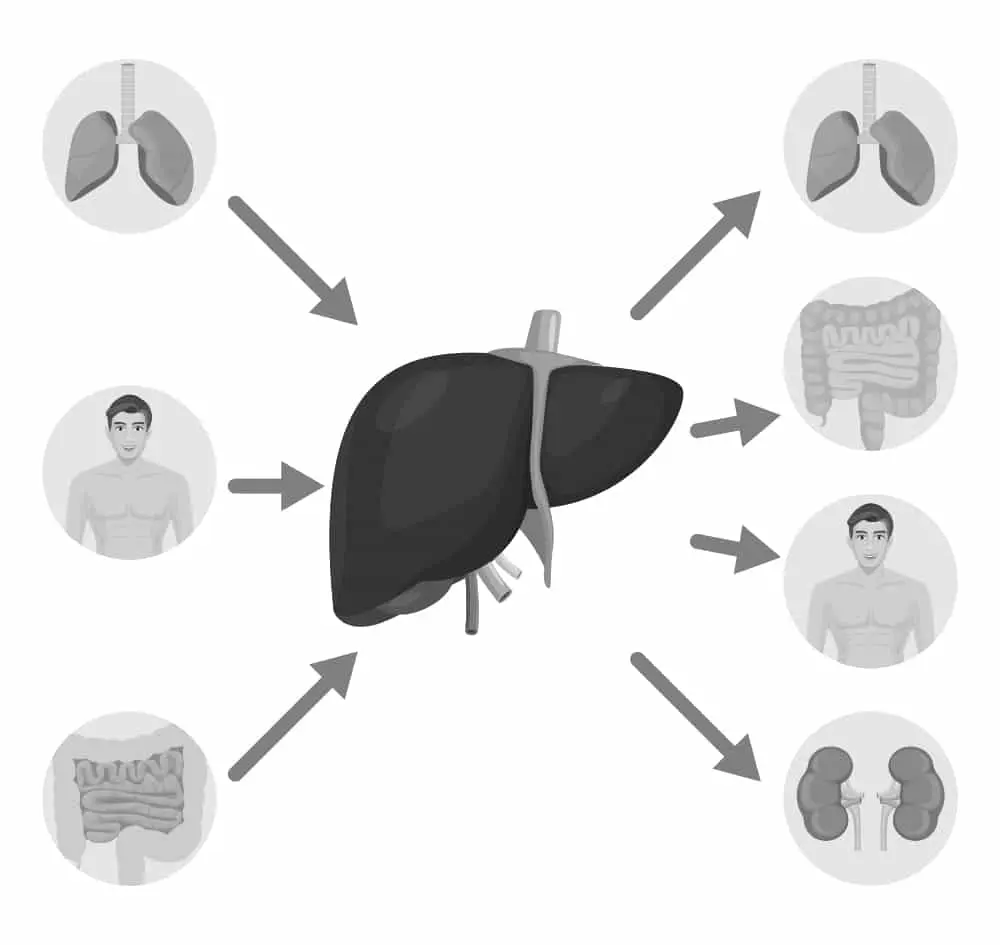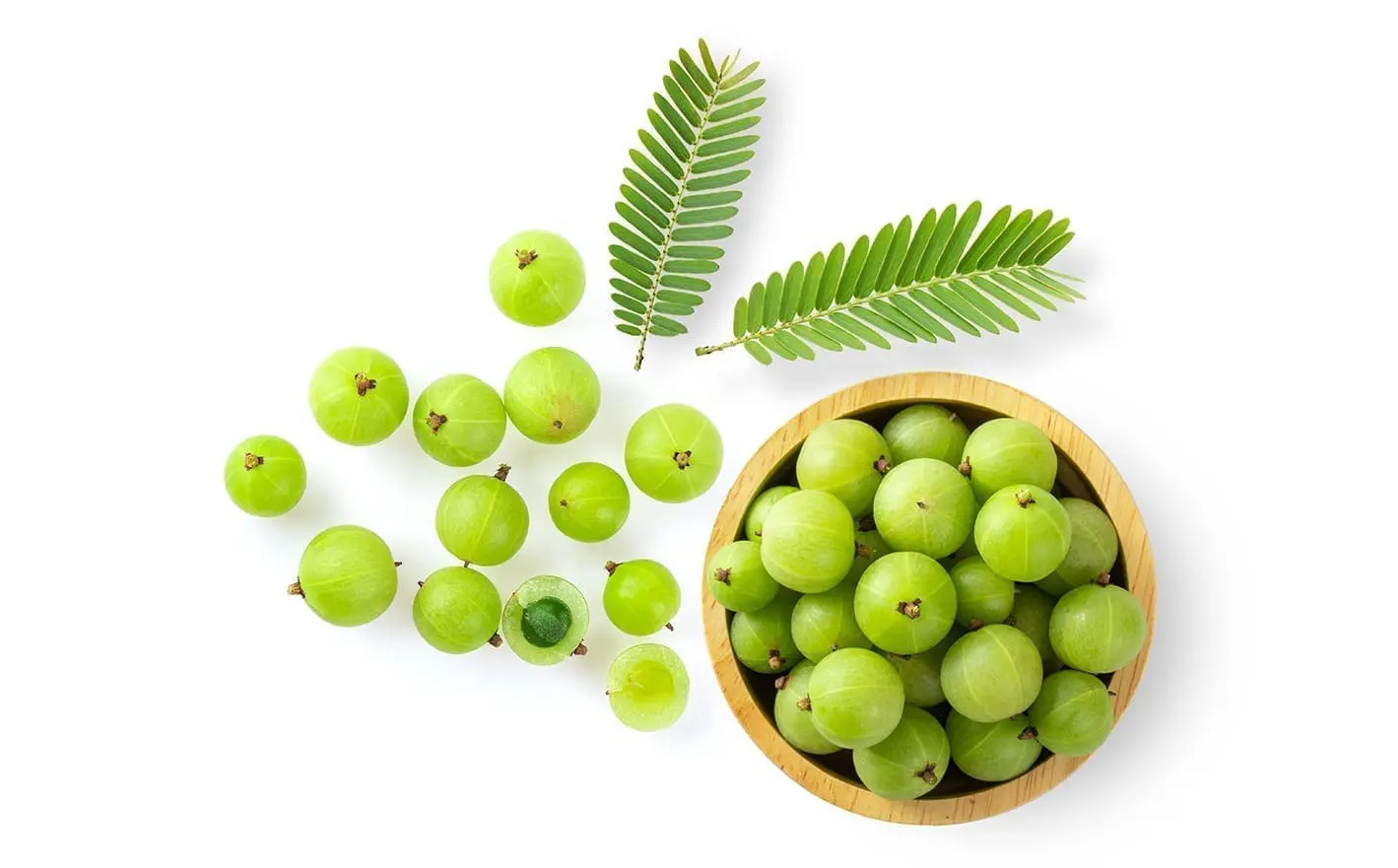Berries have some of the highest levels of antioxidant phytochemicals of all edible plants.
There are countless examples. Wild blueberries—with their high levels of dimethylresveratrol—are so medicinal that they’re right up there with top adaptogens like ashwagandha, ginseng, and Rhodiola in terms of what they can do for your vitality.
Nature tends to pack a massive number of health-promoting compounds into berries, and amla is no exception.
Also known as Indian Gooseberry, Phyllanthus emblica, and Amalaki in Sanskrit, amla berries are markedly sour and astringent. Astringency results from the presence of tannins, compounds that tend to be bitter in flavor and are often robust antioxidants.
Ask any herbalist, and they’ll confirm that sometimes the most powerful herbs and foods are the ones that are the roughest on the taste buds.
Eating amla berries or amla powder is not for the faint of heart.
They’re an extremely potent edible tonic, but you won’t find them in a cobbler or smoothie unless the person making it is a hardcore health enthusiast. They’re 100% worth eating if you can handle them, but of course, standardized extracts in capsules are highly effective too.
Amla berries have been used in Ayurvedic medicine for thousands of years to promote metabolism, digestion, detoxification, immunity, and cardiorespiratory health. According to Ayurvedic herbal practitioners, amla is said to pacify the Pitta Dosha, which is associated with the fire element.
An excess of Pitta can produce irritability, excess heat in the body, and gas, and thus any herb that settles this Dosha will be calming to the digestive tract and nervous system. Ancient traditions like Ayurveda had an intuitive understanding of the connection between the brain and the gut, something that modern science is finally beginning to understand with its concept of the microbiota-gut-brain axis.
Although it may not taste remotely as good as its brother and sister fruits like blueberries, strawberries, or raspberries, Amla has many scientifically-documented health effects that make it an excellent choice for those wishing to support healthy detoxification, circulation, and inflammation response.

Amla Promotes Detoxification By Upregulating Glutathione Production
As mentioned, amla berries are quite sour, which is significant from the perspective of classical herbalism. In Chinese medicine, a sour flavor is an indication that an herb tends to support the liver.
In the case of amla, this connection is particularly obvious, as it has been shown to increase glutathione synthesis and therefore can assist the liver with removing toxins from the body.
In a 2008 study, the researchers gave amla berry extract to rats who were exposed to cigarette smoke and measured whether or not it was able to promote healthy antioxidant generation as a protective response [1]. They found that amla didn’t just increase glutathione, but also enhanced the activity of the glutathione S-transferase (GST) enzyme, a compound that facilitates glutathione’s attachment to toxins so they can be effectively shuttled out of the body.
The amla extract also boosted the natural production of the enzymes superoxide dismutase (SOD) and catalase (CAT), two molecules that are also known as “first line defense” antioxidants that can protect cells from all manner of free radical insult.
In another study in which rats were given significant doses of alcohol, amla was also supportive of protective antioxidant generation [2], working on the very same compounds that were observed in the cigarette smoke study.
In a study done on human smokers, amla showed similar protective effects, enhancing healthy inflammation response, mood, energy, circulation, hemoglobin, and lung function versus placebo [3].
Glutathione is the body’s master antioxidant, and as such it wears many, many hats. It not only removes toxic compounds from the body, but also regulates inflammatory cytokines, supports healthy immunity by balancing different families of T-cells, and quenches mitochondrial free radicals.
Any natural substance that promotes glutathione production is something you want in your regimen, as it serves myriad roles in the body. Thus, amla is among some of the more potent herbs for protection against toxins and free radicals.
Amla Supports Healthy Circulation and Cholesterol Levels
Originally known by the much more unwieldy term endothelium-derived relaxing factor, nitric oxide is one of the most essential compounds that your body uses to regulate blood flow. Recently, it’s also gotten significant attention for its role in healthy immune function, and certain breathing techniques have even been found to boost nitric oxide production in the sinuses, where they’re needed most.
A study in 2013 demonstrated that 500 milligrams of an amla extract could increase nitric oxide by over 50% in human participants [4]. This study also found that amla was able to enhance the production of glutathione, echoing the previously mentioned studies [1-2] that showed its effects on endogenous antioxidant production and protection against toxic insults.
The researchers also noted that amla was able to promote healthy cholesterol levels, including LDL, HDL, VLDL, and triglycerides. A more recent study also found similar benefits for healthy cholesterol synthesis and noted increases in nitric oxide production as well [6].
Nitric oxide is essential for cardiovascular health but is also known to enhance focus and athletic performance. This is why we’ve included 500 mg of a clinically-researched organic amla berry extract in CHOQ Action 2.0.
Although dietary cholesterol is certainly a factor in maintaining heart health, around 80% of the cholesterol in your body is produced inside your body, particularly in the liver and intestines. Supporting the healthy synthesis of cholesterol in the liver is an extremely important part of promoting cardiovascular wellness. Amla is in many ways a liver herb, as it enhances detoxification, so it’s not surprising that it has this benefit.
Cholesterol can also turn into a free radical. Oxidized LDL will steal electrons from the cells that make up the inner lining of your veins and arteries, and antioxidants like glutathione can donate electrons to oxidized cholesterol and neutralize it so that it no longer behaves badly in your bloodstream.
Amla berry extract has also been demonstrated to support healthy systolic and diastolic blood pressure levels in human participants [5], furthering its reputation as an excellent herb to promote cardiovascular health.

Amla Promotes Healthy Inflammation Response
When it comes to maintaining all-systems vitality, few things are more important than promoting a healthy inflammation response.
In a 2019 study, amla berry extract was given to 59 participants, and various biomarkers were measured relating to oxidative stress, inflammation response, and endothelial function. The study showed that amla was able to support healthy levels of hsCRP [6], a compound related to the inflammation response which is often used as an indicator of cardiovascular wellbeing.
This study also measured the levels of a compound called malondialdehyde (MDA), a particularly destructive free radical that’s often used in research as a biomarker to determine oxidative stress [7]. Amla reduced MDA levels by 31% in the high dose (1,000 mg per day) group, demonstrating its powerful effects as a quencher of free radicals.
Glutathione, SOD, and catalase are all known to support the body’s inflammation response by acting as free radical scavengers, and thus are all associated with cardiovascular health. Since amla has been shown by multiple studies to promote the body’s generation of these endogenous antioxidants, the findings of this study aren’t surprising.
A Fruit for the Times
It’s not easy to be healthy these days.
Toxins, fears, and a general malaise are more common than they should be. Fortunately, we live in the information age, which means it’s easier than ever to access the ancient wisdom as well as the cutting-edge science that we need to survive the times.
In addition to practices like yoga, meditation, breathing techniques, and mindfulness, superfoods and adaptogenic herbs are some of the most readily accessible tools we have to promote our wellbeing and thrive amidst the chaos. The more of these little-known gems like amla we can discover and introduce into our daily regimens, the better off we are.
Whether you choose to eat it or take it in capsule form, if you’d like to open up your circulation, enhance detoxification, and support healthy levels of inflammatory cytokines, then amla may be an excellent herbal ally.
References
- Islam, A., Auddy, B., Gupta, M., & Ghosal, S. (2008). BENEFICIAL EFFECT OF PHYLLANTHUS EMBLICA FRUIT EXTRACT ON CIGARETTE SMOKE INDUCED IMPAIRED ANTIOXIDANT STATUS IN RATS. Pharmacologyonline, Volume 2
- Damodara Reddy, V., Padmavathi, P., Gopi, S., Paramahamsa, M., & Varadacharyulu, N. (2010). Protective Effect of Emblica officinalis Against Alcohol-Induced Hepatic Injury by Ameliorating Oxidative Stress in Rats. Indian journal of clinical biochemistry : IJCB, 25(4), 419–424.
- Tuhin Kanti Biswas, Shrabana Chakrabarti, Srikanta Pandit, Utpalendu Jana, Subrata Kumar Dey (2014) Pilot study evaluating the use of Emblica officinalis standardized fruit extract in cardio-respiratory improvement and antioxidant status of volunteers with smoking history, Journal of Herbal Medicine, 4(4) 188-194
- Usharani, P., Fatima, N., & Muralidhar, N. (2013) 6, 275–284. https://doi.org/10.2147/DMSO.S46341
- Usharani, P., Sudharani, E., KiranKishore, K., & Raveendranath, P. (2017). IJPSR 8(10), 4138-4146
- Usharani, P., Merugu, P. L., & Nutalapati, C. (2019). BMC complementary and alternative medicine, 19(1), 97.
- Khoubnasabjafari, M., Ansarin, K., & Jouyban, A. (2015). BioImpacts : BI, 5(3), 123–127. https://doi.org/10.15171/bi.2015.20






